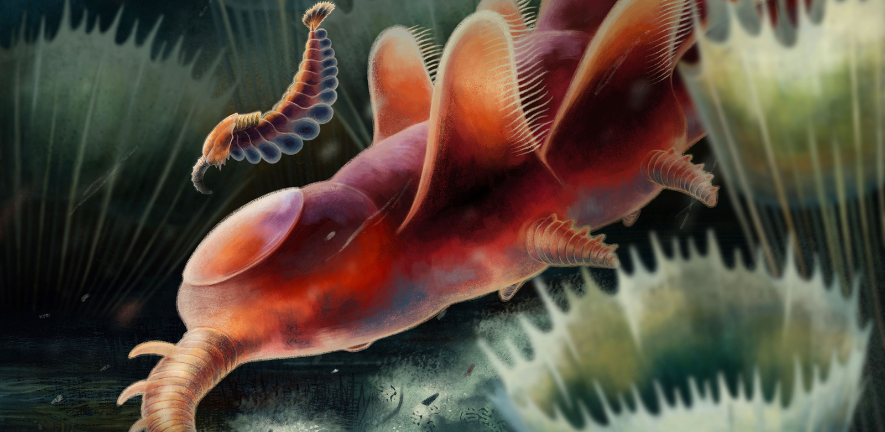
Submitted by Debbie Birkett on Thu, 24/11/2022 - 10:12
Exceptional fossil deposits such as the Burgess Shale in Canada and Chengjiang in China, which preserve soft tissues and internal organs alongside typical shells and ‘hard parts’, provide the oldest evidence for many major animal groups. While many of these fossils can be readily recognized as relatives of modern groups, including arthropods (e.g. centipedes, crabs, spiders) and molluscs (e.g. clams, squid, snails), others were – at first – more challenging to place. It is only relatively recently that some of these ‘weird wonders’ have been placed in ‘stem groups’ (extinct groups that are most closely related to a modern, extant group), helping to uncover how these modern groups evolved. Figure 1. Artistic reconstruction of the Welsh fossils. Artwork by F. Anthony
The Burgess Shale stem group arthropod Opabinia holds the crown of ‘weirdest wonder’. This animal is best known for its distinctive unpaired, flexible head appendage that terminates in a spiny claw – a departure from the paired feeding appendages in its closest relatives. In a study recently published in Nature Communications, Department of Zoology postdoc Stephen Pates described a new fossil species that shares many features with Opabinia but is 40 million years younger (reconstruction above). The new fossils come from a sheep field in mid Wales, and suggest that the unusual fused head appendage in Opabinia (also present in the new Welsh fossils; see images below) might be important for our understanding of how the arthropod head evolved, rather than being a strange innovation in the time of the weird wonders
Figure 2. A new species of stem group arthropod from Wales with a similar morphology to the Burgess Shale weird wonder Opabinia. In particular note the presence of the proboscis – an annulated fused head appendage (right)
Read more: Stephen Pates, Joseph P. Botting, Lucy A. Muir & Joanna M. Wolfe (2022) Nature Communications 13, Article number: 6969. https://doi.org/10.1038/s41467-022-34204-w
Figure 3. A second smaller specimen was also discovered. Differences in size and the presence of distinct features mean that currently we don't know if this is a new species or an earlier life stage. Both specimens have spines on their proboscises.


